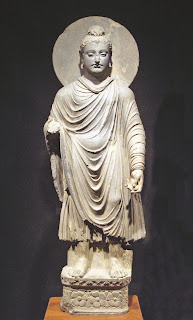| The Buddha's life is told as an allegory, the heroic journey we can all travel. |
In this fantasy sequence, how Siddhartha did it is completely not mentioned -- how he utilized the meditative absorptions or jhanas to temporarily purify consciousness then practicing for insight by mindfulness of dependent origination (vipassana-paticca samuppada), which would be kind of hard to make a Hollywood movie about. Instead, Keanu Reeves does what he can to paint the wrong picture in our minds.
Born in Kapilavastu, Shakya Land (modern Kabul, Bamiyan, Mes Aynak, Afghanistan), Prince Siddhartha was destined to a luxurious life as a royal (kshatriya). He had three palaces -- one in each seasonal capital (due to the weather) -- specially built for him. The whole family, led by King Suddhodana, enjoyed the capitals.
Prince Siddhartha at age 29 left and escaped his palaces, accompanied by Channa his driver, on his grand white pony, Kanthaka, leaving behind the luxurious life of a royal to become a wandering ascetic on a quest for enlightenment (bodhi), awakening from the illusion of samsara, renouncing the lower for the superior, slavery for liberation (moksha).
Sitting under a pipal tree, now known as the Bodhi Tree ("Enlightenment Tree") in Bodh Gaya ("Enlightenment Grove" in the modern state of Bihar, India), he felt it was time to vow never to give up until he had discovered the ultimate Truth.
After 49 days of meditating, at the age of 35, he attained enlightenment (bodhi) and realized nirvana ("the end of all suffering"). Prince Siddhartha Gautama from then on came to be known as the Buddha or "Awakened One," but he had many other epithets and referred to himself as the Tathagata ("Wayfarer," lit. the "Thus Come One, Well Come One, Well Gone One").
 The Buddha is also sometimes translated as "The Enlightened One." Often, he is referred to in Buddhism as Shakyamuni or "The Sage (Muni) of the Shakyas (Scythians)."
The Buddha is also sometimes translated as "The Enlightened One." Often, he is referred to in Buddhism as Shakyamuni or "The Sage (Muni) of the Shakyas (Scythians)."
The Buddha Gautama (to distinguish him from 28 previous buddhas he mentions of the long ago past) is thought of by the Brahmins of his day and the Hindus of today as an avatar (divine incarnation) of Lord Vishnu in the Puranic texts of the Vedas.
- (But one should realize that Hindus are also taught that Lord Krishna and Jesus Christ are also avatars of Vishnu because of their peaceful teachings and sustaining ways, Vishnu being the Sustainer in the trinity conception of "GOD" in Brahmanism/Hinduism, with Brahma as the Creator and Shiva as the Destroyer).
In the Bhagavata Purana he is 24th of 25 avatars, prefiguring a forthcoming final incarnation (Maitreya). A number of Hindu traditions portray the Buddha as the most recent of ten principal avatars, known as the dasavatara ("Ten Incarnations of God"). But the Buddha clearly and repeatedly stated that he was not a God (brahma), not a god (deva), not a messenger-god (gandharva), not any of those things. When forced to say what he was then, he simply answered, "awake."
The Buddhist Rebirth Tale Dasharatha Jataka (Jataka Atthakatha) represents Rama as a previous incarnation of the Buddha as the Bodhisattva ("Buddha-to-be") and supreme Dharma King of great wisdom. A great deal of Indian mythology attached to him although he tried to teach people to understand better than adhering to archaic myths.

































































































































































































































No comments:
Post a Comment